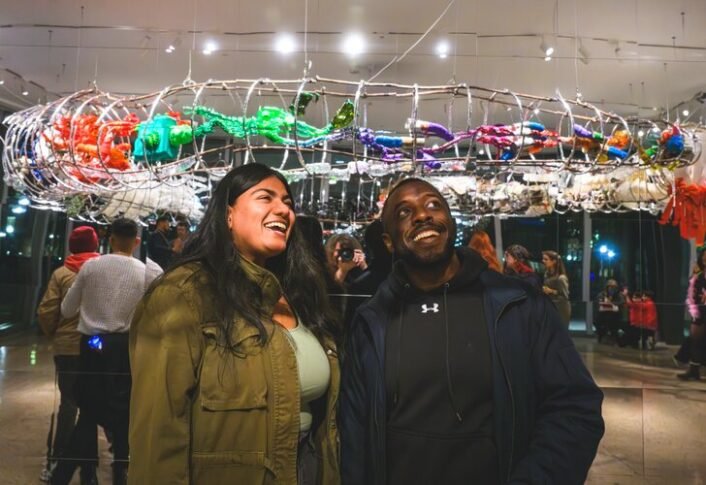Machine Dazzle and his ouroboros of sustainability
Two Guests at Feel Good Friday Queer Night at UMMA
There is nothing small about Machine Dazzle. A self-proclaimed “queer maximalist,” Dazzle is an artist and designer whose stories come alive through his work, and at the University of Michigan Museum of Art, his latest story is … verbose.
“Ouroboros”—inspired by the ancient circular symbol of the same name that depicts a snake devouring its own tail and represents the eternal cycle of destruction and rebirth—visually represents the impact of manufactured waste and its unending reproduction.
“It has these windows that made me feel like I was being bathed in clear light, or clear water,” he recalls of UMMA’s Stenn Gallery, home to “Ouroboros.”
“I just started envisioning this ring-like sculpture hanging in the room, which I later understood to be the ouroboros, so that’s where it started.”
Constructed from harvested trash from the Huron River, and as a nod to the Flint water crisis, Dazzle sees this jetsam as an opportunity for new life.
“I’ve always loved found objects, and I love environmental health,” he said. “It always makes me sad to see human garbage in beautiful natural spaces.”
Coming off of a solo exhibition at New York City’s Museum of Arts and Design, and a commission for the Guggenheim, Dazzle took on a residency with Materials for the Arts where he focused on returning their collection of upcycled materials “back into nature” for his art.
“All of these dead things come in discarded, unwanted, and I just wanted to give them a little bit of life. So I started cutting them up, crushing them, forming them, crumpling them, melting them, and all of a sudden, they started to look like life forms, which was exciting.”
This interest in giving second life to objects that appear to be long gone is one that he brought with him to Ann Arbor.
As “Ouroboros” continues to develop and grow, Dazzle talks about the speed at which human-manufactured garbage continues to multiply—”seemingly reproducing itself,” he said during a Penny Stamps Distinguished Speaker Series as part of his U-M Stamps School of Art & Design Roman J. Witt artist residency.
“There is so much waste from humans—plastic, glass, metal—there’s so much of it. And we know there will be more for the sake of our own convenience, so it’s as if the waste is reproducing itself. And this is specifically human garbage—there’s no other species making this, this is manmade garbage. So I gave all of the garbage human genitals.”
“Ouroboros” was presented in three acts. In the initial act, the gallery served as a canvas for Dazzle’s lavish interpretation of the ouroboros. Subsequent acts introduced dynamic shifts and additional layers to its circular structure.
“There are a lot of individual sculptures within ‘Ouroboros.’ And they’re all connected. Everything has a story. There are so many different worlds in a body, in a mind, even in one human. Infinity is within all of us. I just keep expanding the sculpture.”
Act three will be unveiled this Friday, June 14, at UMMA as the sculpture spawns 13 wearable pieces that will be activated by a group of performers. This final act, a celebration coinciding with LGBTQ Pride Month, symbolizes the interconnectedness of the installation with contemporary narratives.
The wearable art will be displayed on mannequins until Aug. 25 when the exhibition closes. As Dazzle is widely known for his colorful, statement-making wearable art in collaboration with performance artist and MacArthur Fellow Taylor Mac, this is a return to form for the designer.
Adding a sonic element to his installation is an aspect he is especially excited about.
In contrast to a typical gallery or museum experience which is intended to be silent, Dazzle wanted a more immersive experience.
“I wanted to fill the empty space with sound,” he said. “So I took a lot of this garbage and turned it into, almost, musical instruments and things that make sounds. I recorded 170 different sounds underwater which I turned into 15 different tracks that are within the sculpture.”
He reworked those tracks into a 14-minute song for the runway performance, which will debut at Friday’s event.
And when it comes to making art from these single-use plastics, Dazzle said: “It’s going to be on the earth for hundreds of years anyway, so I may as well turn it into something that’s telling a story.”
This is Machine Dazzle’s first museum installation commission and his first exhibition in the Midwest.
The “Ouroboros” runway show at UMMA is free and open to the public.
SUPPORT
Machine Dazzle: Ouroboros is produced by Chrisstina Hamilton, Jim Leija, Andrew Cohen, Matt Casadonte, and Niki Fairchild Azevedo with studio support from Ana Trujillo Garcia. Sound editing by Matthew Girard.
Machine Dazzle: Ouroboros is presented in partnership with the Roman J. Witt Artist in Residence Program of the Penny W. Stamps School of Art & Design, with lead support provided by the U-M Office of the Provost, U-M Arts Initiative, Candy and Michael Barasch, Catherine Glynn Benkaim and Barbara Timmer, Susan and Richard Gutow, and the U-M LSA Honors Program. Additional generous support is provided by the U-M School of Social Work. Special thanks to Barbara Tober and the Acronym Fund. Machine Dazzle is represented by Pomegranate Arts.

